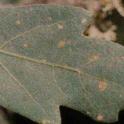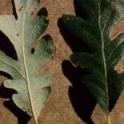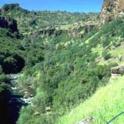 Scientific name Quercus douglasii Hook. & Arn.
Scientific name Quercus douglasii Hook. & Arn.
Common names Blue, white, mountain, rock, iron, post, jack, Douglas
Height Usually 20-60 ft.; tallest over 90 ft.
Mature Tree DBH (Diam. at Breast Ht.) Less than 1 ft., up to 2 ft.; largest over 6 ft

 Longevity Long-lived, 175-450 yrs.
Longevity Long-lived, 175-450 yrs.
Acorn Matures first year; variable in shape; warty scales; Cup very shallow
Shade Tolerance Seedlings not tolerant
Sprouting Variable sprouter; not vigorous on dry sites.
Sites Hot, dry sites with rocky soils, 12-40 in. deep; can’t compete with live oak on better sites

Foliage Deciduous; blue-gray color; smooth or slightly to deeply lobed edges; 1-3 in. long and 1/2-2 in. wide.
Fire Tolerance Tolerates grass fires; not hot brush fires
Elevation 500-2000 ft. in north; up to 5000 ft. in south

Associates Grades into open valley oak stands at low elevations; blends into denser live oak stands at higher elev.; foothill pine common
Identification Notes Confused with valley oaks when leaves are dust
View Blue Oak Woodland & Wildlife Habitat information
View Blue Oak-Foothill Pine Woodland & Wildlife Habitat information
 Scientific name Quercus lobata Nee
Scientific name Quercus lobata Nee
Common names Valley, white, California white, mush, water, swamp, roble
Height 40 to 120 ft.
Mature Tree DBH (Diam. at Breast Ht.) 1-4 ft.; largest over 8 ft.
Longevity Long-lived, 200-250 yrs.
 Acorn Matures first year, variable but large and tapered, cup over 1/3 of nut and warty
Acorn Matures first year, variable but large and tapered, cup over 1/3 of nut and warty
Shade Tolerance Seedlings somewhat tolerant, mature trees intolerant
Sprouting Not a vigorous sprouterVariable sprouter; not vigorous on dry sites
Sites Prefers fertile, well-drained bottomland soils, streambeds, and lower foothills
 Foliage Deciduous; leaves leathery with shiny, dark green-yellow above and grayish below; deep irregular lobes; 2-4 in.
Foliage Deciduous; leaves leathery with shiny, dark green-yellow above and grayish below; deep irregular lobes; 2-4 in.
Fire Tolerance Not tolerant of fires
Elevation 500-800 ft. in north; up to 5600 ft. in south
Associates Blue and Oregon white oak; sometimes interior live oak
Identification Notes Confused with Oregon white oak but acorns pointed with warty cups; Seedlings not tolerant
View Valley Oak Woodland & Wildlife Habitat information
 Scientific name Quercus garryana Dougl
Scientific name Quercus garryana Dougl
Common names Garry oak, white oak, Oregon oak
Height 50 to 80 feet
Mature Tree DBH (Diam. at Breast Ht.) 2-3 ft.; largest over 5 ft.
Longevity 100-200 years
 Acorn Matures first year; 1 in. long with shallow cup
Acorn Matures first year; 1 in. long with shallow cup
Sprouting Excellent sprouter
Shade Tolerance Intermediate tolerance as seedling and intolerant as tree matures
Sites Cool humid sites near coast to hot, dry sites inland
 Foliage Deciduous; 4-6 in. long; evenly and deeply lobed with rounded leaf tips; lustrous dark-green and shiny above and pale green below
Foliage Deciduous; 4-6 in. long; evenly and deeply lobed with rounded leaf tips; lustrous dark-green and shiny above and pale green below
Fire Tolerance Maintained in open stands by regular, low-intensity fires
Elevation 500-3000 ft.
Associates Douglas-fir and mixed evergreen forests; Pacific madrone and tanoak
Identification Notes Can be distinguished from valley oak by acorns
CalScape page on Oregon White Oak
View Oregon White Oak Woodland habitat information on CNPS website
 Scientific name Quercus engelmannii Greene
Scientific name Quercus engelmannii Greene
Common names Engelmann, mesa
Height 20 to50 feet
Mature Tree DBH (Diam. at Breast Ht.) 1-2 feet
Longevity 100-200 years
 Foliage Considered deciduous but foliage may persist during winter; similar toblue-gray color of blue oak
Foliage Considered deciduous but foliage may persist during winter; similar toblue-gray color of blue oak
Acorn Matures first year
Sprouting Variable sprouter
Shade Tolerance Seedlings tolerant, mature trees intolerant
Sites Warm, dry fans and foothills
 Fire Tolerance Very tolerant of hot fires
Fire Tolerance Very tolerant of hot fires
Elevation Under 4000 feet
Associates In pure stands and with coast live oak
General Notes Very limited range in southern California makes protection a high priority
CalScape page on Englemann Oak
View Englemann Oak Habitat information on CNPS website
 Scientific name Quercus agrifolia Nee
Scientific name Quercus agrifolia Nee
Common names Coast live oak, California live oak, encina
Height 20 to 40 feet; may reach 80 feet
Mature Tree DBH (Diam. at Breast Ht.) 1-4 feet
Longevity Long-lived, 125 to 250 years
 Acorn Matures first year; 3/4 to 2-3/4 in.; cup over 1/3 of nut and not warty
Acorn Matures first year; 3/4 to 2-3/4 in.; cup over 1/3 of nut and not warty
Sprouting Very vigorous sprouter
Shade Tolerance Shade tolerant throughout life
Sites Common on valley floors or not-too-dry fertile slopes
 Foliage Evergreen; 1-3 in.; roundish; dark and shiny above with gray or rusty fuzz underneath; cupped or spoon-shaped
Foliage Evergreen; 1-3 in.; roundish; dark and shiny above with gray or rusty fuzz underneath; cupped or spoon-shaped
Fire Tolerance Very tolerant of hot fires due to thick bark
Elevation Below 3000 ft. in north and up to 5000 ft. in south
Associates Forms pure stands; also grows with interior live oak and coast live oak
Identification Notes Confused with interior live oak but rounded and cupped leaves
CalScape page on Coast Live Oak
View Coastal Oak Woodland & Wildlife Habitat information
 Scientific name Quercus wislizeni A. DC.
Scientific name Quercus wislizeni A. DC.
Common names Interior live oak, highland live oak, Sierra live oak
Height Usually 30-75 ft.; shrub form 8-10 ft.
Mature Tree DBH (Diam. at Breast Ht.) 1 to 3 feet
Longevity 150 to 200 years

 Acorn Matures second year; very slender, pointed, 1 in. long; cup over half the nut
Acorn Matures second year; very slender, pointed, 1 in. long; cup over half the nut
Sprouting Very vigorous sprouter
Shade Tolerance Somewhat shade tolerant
Sites Wide range, from valleys to foothills; moister areas than blue oak

 Foliage Evergreen with smooth to very spiny-toothed; dark green above and lighter below with waxy/shiny surface; 1-4 in.; flat
Foliage Evergreen with smooth to very spiny-toothed; dark green above and lighter below with waxy/shiny surface; 1-4 in.; flat
Fire Tolerance Not very tolerant, but sprouts well after fire
Elevation Below 2000 feet in north and above 6200 feet in south
Associates In pure stands or mixed with blue and/or coast live oak, and valley oaks in So. California
Identification Notes Confused with coast live oaks; distinguished by flat leaves
CalScape page on Interior Live Oak
View Interior Live Oak Chaparral habitat information on CNPS website
View Interior Live Oak Woodland habitat information on CNPS website
 Scientific name Quercus chrysolepis Liebm
Scientific name Quercus chrysolepis Liebm
Common names Canyon live oak, canyon oak, gold cup oak, live maul, maul oak, white live oak
Height 60 to 80 feet
Mature Tree DBH (Diam. at Breast Ht.) 1-4 ft; largest over 5 feet
Longevity Up to 300 years
Sprouting Variable sprouter
Acorn 1-1/2 in. long; thick, shallow cup

 Foliage Evergreen; 3 in. long; persist 3 or 4 seasons on tree; usually not lobed; leathery
Foliage Evergreen; 3 in. long; persist 3 or 4 seasons on tree; usually not lobed; leathery
Shade Tolerance Tolerant of shade
Fire Tolerance Sensitive to hot fires
Elevation 300 to 5000 feet
Associates Found with mixed conifer, chaparral, and woodland species; tanoak, Douglas-fir, Pacific madrone, coast live oak
Sites Most widely distributed oak in CA.; sheltered north slopes and steep canyons
Identification Notes Both a shrubby and tree form; very dense wood
CalScape page on Canyon Live Oak
View Canyon Live Oak Chaparral habitat information on CNPS website
View Canyon Live Oak Forest habitat information on CNPS website
 Scientific name Quercus kelloggii Newb.
Scientific name Quercus kelloggii Newb.
Common names Black, California black oak
Height 60 to 90 feet
Mature Tree DBH (Diam. at Breast Ht.) 1 to 4 feet
Longevity 100-200 yrs., occasionally up to 500 years
 Acorn Matures second year; 1-1/2 in. long; thin cup over half the nut
Acorn Matures second year; 1-1/2 in. long; thin cup over half the nut
Sprouting Excellent sprouter
Shade Tolerance Intermediate tolerance as seedling and intolerant as tree matures
Sites More common on forest sites; found on moister hardwood rangelands; well-drained soils
 Foliage Deciduous; 5 in. long; 5-7 lobed; spiny leaf tips; dark yellow-green above and pale yellow-green below
Foliage Deciduous; 5 in. long; 5-7 lobed; spiny leaf tips; dark yellow-green above and pale yellow-green below
Fire Tolerance Very sensitive to cambium being killed in hot fires
Elevation 200 to 6000 feet
Associates Most common with tanoak, madrone, mixed conifer forest species;, also with coast live oak, interior live oak, and blue oak
General Notes Protected by Forest Practice Act on timberlands; commercial properties for finished lumber
CalScape page on California Black Oak
View California Black Oak Forest habitat information on CNPS website
















